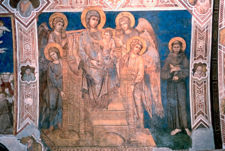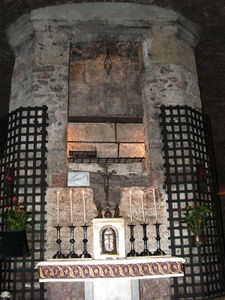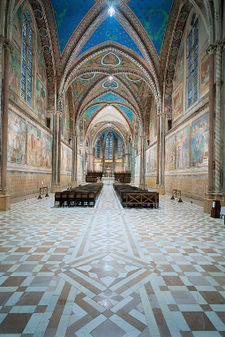Basilica of San Francesco d'Assisi
2007 Schools Wikipedia Selection. Related subjects: Architecture
![]() The Basilica of San Francesco d'Assisi (St Francis), the mother church of the Franciscan Order, is a World Heritage Site in Assisi, Italy.
The Basilica of San Francesco d'Assisi (St Francis), the mother church of the Franciscan Order, is a World Heritage Site in Assisi, Italy.
History
The Franciscan monastery ( Sacro Convento) and the lower and upper church (Basilica inferiore e superiore) of St Francis were begun immediately after his canonization in 1228. Simone di Pucciarello donated the land for the church, a hill at the west side of Assisi, known as "Hill of Hell" (because here the criminals were put to death). Today, this hill is aptly called "Hill of Paradise".
The foundation stone was laid by Pope Gregory IX on 17 July 1228, although construction may already have been begun. This impressive church was designed and supervised by brother Elia Bombardone, one of the first followers of St. Francis and the former provincial minister of Syria. The lower basilica was finished in 1230. On Pentecost 25 May 1230 the uncorrupted body of St. Francis was brought in a solemn procession to the lower basilica from its temporary burial place in the church of St. George (now the basilica of St. Clare). The construction of the upper basilica was began after 1239. Construction was completed in 1253. Its architecture is a synthesis of Romanesque and French Gothic artwork, establishing many of the typical characteristics of Italian Gothic architecture.
The churches have been decorated by the greatest late medieval Roman, Umbrian and Tuscan artists of their time, giving these churches an unequaled importance in the development of Italian art. The lower church has frescos by renowned late-medieval artists, such as Cimabue and Giotto; in the upper church are a series frescoes depicting scenes in the life of St Francis attributed to Giotto and his circle.
Pope Nicholas IV, the former Master-General of the Order of Franciscans, raised the church to the status of papal church in 1288.
The Piazza del Loge, the square leading to the church, is surrounded by colonnades constructed in 1474. They housed the numerous pilgrims flocking to this church.
On 27 October 1986 and January 2002, Catholic pontiff Pope John Paul II gathered in Assisi with the leaders of the great world confessions to pray for peace.
On September 26, 1997 Assisi was struck by an earthquake which caused four fatalities. The Basilica was badly damaged (part of the vault collapsed, carrying with it a fresco by Cimabue), and was closed for two years for restoration.
The lower basilica
Brother Elia had designed the lower basilica as an enormous crypt with ribbed vaults. He had acquired his experience by building huge sepulchres out of hard rock in Syria.
Entering the lower basilica via the side portal in Gothic style (second half of the 13th c.) with two wooden doors (Umbrian craftsmanship from the 16th c.), one sees at the other side of the vestibule the chapel of Cardinal Egidio Albornoz, papal legate in charge of the Papal States (from 1350 to 1367). It is dedicated to St. Catherine of Alexandria. The frescoes with the eight episodes from the life of St. Catherine were painted in 1368-1369 by ‘Andreas pictor de Bononia’. This painter, called Andrea, is most probably Andrea de’ Bartoli (c. 1349 - 1369), the court artist of Albornoz (and not Andrea da Bologna, as usually, but wrongly, attributed). The saints in this chapel were painted by Pace di Bartolo d'Assisi (1344-1368).
On the left side is the small Chapel of St. Sebastian with a canvas by Giorgetti and episodes of the life of the saint on the walls by G. Martelli. On the right side there are two monuments : the mausuleum of Giovanni de' Cerchi and the mausuleum of John of Brienne, king of Jerusalem and emperor-regent of Constantinople.
The lower basilica consists of a central nave with several side chapels with semi-circular arches. The nave is decorated with the oldest frescoes in the church by an unknown artist, called Maestro di San Francesco. They feature five scenes from the Passion of Christ on the right side, while on the left side equally five scenes from the Life of St. Francis. By this juxtaposition, the Franciscans wanted to contribute to the idea of their founder as a second Christ.
They are connected by a low blue-painted ceiling decorated with golden stars. Most images on the lower walls have decayed to leave almost no trace, except on the right wall fragments of Virgin and Child with an Angel by Cimabue.
These frescoes, executed in tempera on dry plaster, were completed about 1260-1263. They are considered by many as the best examples of Tuscan wall paintings prior to Cimabue. As the popularity of this church increased, side chapels for noble families were added between 1270 and 1350, destroying the frescoes on the opened walls.
The first chapel on the left is dedicated to Saint Martin of Tours. It was built by Cardinal da Montefiore, and was decorated between 1317 and 1319 with ten frescoes depicting his life by Simone Martini and with a polyptych with figures of saints. These are amongst the greatest works of Simone Martini and the finest examples of 14th century painting. The use of lead white has over the years darkened several passages in these works.
.
The other chapel on the left is dedicated to St. Peter of Alcantara.
The chapels on the right are dedicated to :
- Saint Louis of Toulouse and Saint Stephan with frescoes by Dono Doni (1575) and stained glass, attributed to Simone Martini.
- Saint Anthony of Padua with frescoes by Cesare Sermei (1610,)
- St. Mary Magdalene. This chapel, built by Teobaldo Pontano (bishop of Assisi from 1296 to 1329), contains some of the best works of the workshop of Giotto and maybe by the master himself (about 1320) (wrongly attributed by Vasari to Puccio Capanna). On the lateral walls are scenes from the Life of Mary Magdalene (above the portrait of Teobaldo Pontano), while in the vault there are roundels with busts of Christ, the Virgin, Mary Magdalene and Lazarus.
The nave ends in a richly decorated semicircular apse, preceded with a transept with barrel vaulting.
The frescoes in the right transept depict the childhood of Christ, partly by Giotto and his workshop and the Nativity by the anonymous Maestro di San Nicola. The lowest level shows three frescoes representing St. Francis posthumously intervening in favour of two children. These frescoes by Giotto were revolutionary in their time, showing real people with emotions, set in a realistic landscape.
On the transept wall Cimabue painted his most famous work "Our Lady enthroned and Saint Francis" (1280). This is probably the nearest likeness to St. Francis. This static painting in Gothic style is in stark contrast with the lively frescoes of Giotto.
This right transept also contains the Chapel of Saint Nicolas of Bari, probably commissioned by the papal legate Cardinal Napoleone Orsini. It is decorated with a cycle of 10 frescoes by the (anonymous) Master of the Chapel of St Nicholas (between 1295 and 1305), depicting the miracles and the charity of Saint Nicholas. This cycle has been influenced by the cycle of the Legend of St. Francis in the upper basilica. This confused Vasari into (wrongly) ascribing this frescoes to 'Giottino'. The same master then executed the Annunciation across the entrance of the chapel.
The left transept was decorated by the Sienese painter Pietro Lorenzetti and his workshop between 1315 and 1330 (attributed by Vasari Pietro Lorenzetti and also (wrongly) to Giotto and Puccio Capanna) . This cycle of tempera frescoes are his masterworks. They depict six scenes from the Passion of Christ. Especially the fresco of Deposition of the Cross is highly emotional. In this cycle one can see cast shadows, for the first time since antiquity. There were about 330 work-stages needed to complete this cycle. This means that these frescoes were executed over several years, even with the assistance of his workshop. He also decorated the adjoining chapel of St John the Baptist with the fresco "Madonna dei Tramonti “.
The juxtaposition of the Childhood and the Passion frescoes intend to stress the parallel between the passion of Christ and the compassion of St. Francis.
The papal altar in the apse was made out of one block of stone from Como in 1230. Around the altar are a series of ornamented Gothic arches, supported by columns in different styles. The 12 columns that surrounded the altar were removed in 1870. The fine Gothic walnut choir stalls were completed in 1471 by Apollonio Petrocchi da Ripatransone, with the help of Tommaso di Antonio Fiorentino and Andrea da Montefalco.
Once featuring frescoes depicting an allegory of the Crucifixion by Stefano Fiorentino (destroyed in 1622), the walls of the apse are now covered with a "Last Judgment" by Cesare Sermei di Orvieto (1609-1668).
The paintings in the lunettes of the vaults (1315-20) depict the "Triumph of St Francis“ and three allegories of Obedience, Poverty and Chastity by the so-called Maestro delle Vele (Master of the Assisi vaults), a pupil of Giotto (about 1330).
The stained glass windows in this lower basilica are attributed to Giovanni di Bonino and his workshop.
Crypt
Halfway down the nave one can descend into the crypt via a double stairway. This burial place of St. Francis was found again in 1818. His remains had been hidden by brother Elia to prevent the spread of his relics in medieval Europe. By order of Pope Pius IX a crypt was built under the lower basilica. It was designed by Pasquale Belli with precious marble in neo-classical style. But it was redesigned in bare stone in neo-Romanesque style by Ugo Tarchi between 1925 and 1932.
The ancient stone coffin with iron ties is enshrined in an open space above the altar. In 1934 his most faithful brothers were entombed in the corners of the wall around the altar: brother Rufino, brother Angelo, brother Masseo and brother Leone.
At the entrance of the crypt, an urn with the remains of Jacopa dei Settesoli was added to the crypt. This woman of Roman nobility was the most faithful friend and benefactress of St. Francis. She was at his side in the Porziuncola at the hour of his death.
Friary of St. Francis
Next to the basilica stands the friary Sacro Convento with its imposing walls with 53 Romanesque arches and powerful buttresses supporting the whole complex. It towers over the valley below, giving the impression of a fortress. It was built with pink and white stone from Mount Subasio. It was already inhabited by the friars in 1230. But construction took a long time, with as result different styles intermingling : Romanesque with Gothic style. A major part was built under the reign of Pope Sixtus IV, a Franciscan, between 1474 and 1476.
The friary now houses a vast library (with medieval codices and incunables), a museum with works of art donated by pilgrims through the centuries and also the 57 works of art (mainly of Florentine and Sienese schools) of the Perkins collection.
The belfry, in Romanesque style, was finished in 1239.
Upper basilica
One enters the upper basilica from the loggia of the friary. The slender Gothic style of the upper basilica gives a completely different impression.
Large glass stained windows, placed halfway up the walls, shed their coloured light on the masterworks of Giotto and Cimabue. The windows in the choir were produced by German craftsmen, active around Assisi in the last part of the 13th century. The windows on the left hand side of the nave were made by a French workshop (1270), while those on the right hand side are attributed to the workshop of Maestro di San Francesco. These stained glass windows are among the best examples of 13th c. Italian glasswork.
This bright and spacious basilica consists of a single four-bay nave with cross-vaulted ceiling bordered with patterns of crosses and leaves, a transept and a polygonal apse. The four-ribbed vaults are decorated alternatively with golden stars on a blue background and paintings. The second vault is decorated with roundels with busts of Christ facing St. Francis and the Virgin facing St. John the Baptist. The entrance vault gives us the Four Latin Doctors of the Church : St Gregory facing St Jerome and St Ambrose facing St Augustine. These are ascribed to the Isaac Master.
The choir has 102 wooden stalls with carvings and marquetry by Domenico Indovini (1501). In their centre, on a raised platform, stands the papal cathedra.
The west end of the transept and the apse have been decorated with many frescoes by Cimabue and his workshop (starting in c. 1280). The magnificent Crucifixion, with St. Francis on his knees at the foot of the Cross, stresses again the veneration of the Passion of Christ by St. Francis. Sadly, the frescoes of Cimabue soon suffered from damp and decay. Due to the use of lead oxide in his colours and to the fact that the colours were applied when the plaster was no longer fresh, they have deteriorated and have been reduced to photographic negatives.
Prior to him there had been some decorations in the upper right hand section of the transept by an (anonymous) Northern Master, probably an English artist (1267-1270). He realized the two lunettes and the roundels on the west wall with paintings of the Angel and the Apostles. Another (anonymous) master, the Roman Master, painted the Isaiah and the David and the remainder of the wall under the eastern lunette.
The upper part on both sides of the nave, badly damaged by the earthquake of 1997, was decorated in two rows with in total 32 scenes from the Old Testament (starting with Creation of the World and ending with Joseph forgives his brothers) and the New Testament (from the Annunciation to The Women at the Tomb), while the upper register of the entrance wall is covered with two frescoes Pentecost and Ascension of Jesus. Since it took about six months to paint one bay of the nave, different Roman and Tuscan masters, followers of Cimabue, have performed this series of scenes such as Giacomo, Jacopo Torriti and Pietro Cavallini.
The two frescoes of the life of Isaac (Isaac blesses Jabob and Esau in front of Isaac) in the middle register of the third bay, are traditionally ascribed to the young Giotto (1290-1295) (previously wrongly ascribed to Cimabue by Vasari). But even this has been controversial. Many critics esteem these the work of the anonymous Isaac Master and his workshop. Deducing from stylistic details, attesting to his Roman background, some think that the Isaac Master may have been Pietro Cavallini or a follower. Pietro Cavallini had painted around 1290 a similar fresco Isaac blessing Jacob in the convent of the church Santa Cecilia in Trastevere in Rome. The position of the resting Isaac looks like the same position of the Virgin in Cavallini's mosaic Birth of the Virgin in the apse of the church Santa Maria in Trastevere in Rome. The Isaac Master is considered one of the first practitioners of the true fresco (buon fresco) technique.
But the most important decorations are the series of 28 frescoes ascribed to the young Giotto along the lower part of the nave. Each bay contains three frescoes above the dado on each side of the nave, two frescoes in the east galleries beside the entrance, and two more on the entrance wall. Giotto used the Legenda Maior, the biography of St. Francis by St. Bonaventure (1266) to reconstruct the major events in the life of St. Francis. The prototype for this cycle may have been the (now lost) St Francis cycle by Pietro Cavallini in the church San Francesco a Ripa in Rome. The paintings are so vivid, as if Giotto had been a witness to these events. According to Vasari, they were executed in the period between 1296 and 1304.
However the authorship of Giotto is disputed, due to the ambiguous attributions given in early descriptions of this work. Many Italian critics continue to support the authorship of Giotto and his workshop. But because of small differences in style with the frescoes of Isaac, it is thought that several or even all of these frescoes were painted by at least three separate painters, using the original concept of Giotto : the Master of Legend of St. Francis (the principal painter and probable supervisor of the cycle), the Master of the Obsequies of St. Francis and the Cecilia Master.
The first span of the ceiling is decorated with frescoes of the "Four Doctors of the Church“ ( Jerome, Augustine, Gregory and Ambrose), attributed either to a young Giotto or to one of his followers. The third span presents four heart-shaped medallions of the Christ, Mary, John the Baptist and Francis, painted by Jacopo Torriti.
The cuspidate façade of the upper basilica has a portal in Gothic style with twin doors and a beautiful rose window.














